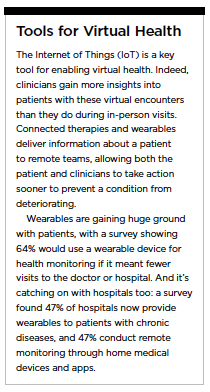As healthcare costs continue to spiral, the need to find effective ways to balance the demands of an aging population becomes more pressing. One approach that has the potential to make a significant difference is virtual health, which allows patients with chronic diseases to be monitored more efficiently without needing to hire more clinicians.
According to Accenture research, gathering information from patients through virtual health platforms rather than in-person encounters can save each U.S. primary care practitioner around five minutes per encounter. This is a time savings equivalent to 37,000 PCPs (18% of the PCPs nationwide) at a value of $7 billion to the U.S. health system.
Virtual health offers patients clinical care through telemedicine and telehealth, connecting them remotely to clinicians and others in their care teams. Virtual health takes several different forms: it can be a video or teleconference between a patient and their doctor; it can be an interaction with an offsite specialist from a local clinic; and increasingly it is becoming a way to monitor patients with chronic conditions, such as diabetes.
Among the benefits of virtual health is that it encourages and enables patient self-management and supports care across the continuum, while reducing the amount of time patients spend traveling to appointments.
There is a growing comfort level among patients with virtual health, with a study finding 60% of U.S. broadband households are interested in remote care. And there are more and more ways in which virtual health can be leveraged to assist patients.
In PharmaVOICE’s November/December Year in Preview issue the role of IoT as a major tool for virtual health was discussed by several industry experts, with many pointing to the potential to have tools that monitor patients’ health day and night, gathering data and feeding into algorithms that provide advice to that patient and their PCP or specialist.
Virtual Trials
 Clinical trials can also be assisted by virtual health, since patients are more inclined to participate if they can do so from their own homes. Benefits to virtual trials include faster recruitment and better retention; fewer geographic, time, and financial hurdles for patients to overcome; and a more diverse patient population. In one example, virtual clinical trials have reduced barriers to participation for Parkinson’s disease patients. In 2019, the National Institute on Aging was set to recruit 3,500 patients with Parkinson’s disease for a clinical trial conducted from their homes — a first for the institute.
Clinical trials can also be assisted by virtual health, since patients are more inclined to participate if they can do so from their own homes. Benefits to virtual trials include faster recruitment and better retention; fewer geographic, time, and financial hurdles for patients to overcome; and a more diverse patient population. In one example, virtual clinical trials have reduced barriers to participation for Parkinson’s disease patients. In 2019, the National Institute on Aging was set to recruit 3,500 patients with Parkinson’s disease for a clinical trial conducted from their homes — a first for the institute.
Virtual trials can also help to improve the quality of data, since it reduces variation in data collection. Moreover, technology advances, including mHealth wearables and remote patient monitoring tools, allow data to be delivered faster, and, increasingly in real time.
Tools used in virtual trials can also point to important and often overlooked study endpoints. For example, continuous temperature sensors can alert trial investigators if a patient has flu onset, an important indicator that can affect the cost and length of a study if not properly identified.
Several companies are pursuing virtual trials. For example, Novartis collaborated with Qualcomm to collect and aggregate medical device data during clinical trials to improve the ease and speed of gathering study participant data and test results.
However, virtual trials will also require a change in practice when it comes to trial design, such as engaging patients in study design and being upfront about how their data will be used. Furthermore, studies will need to demonstrate a focus on patient experience and quality of life.
Virtual studies can also be effective in improving adherence, when integrated with effective programs. One trial enrolled 299 patients — adults and children — with asthma to determine whether a mobile health asthma program could improve outcomes. Participants were given an electronic inhaler sensor to track the use of rescue medication. After a 30-day control period, participants were given one-year’s access to smartphone and web-based applications to view their data, as well as personalized education and disease management support. The results showed use of rescue inhalers fell by 75% and participants with asthma-free days increased by 39%.
A Business Imperative
Pharmaceutical companies are also looking at how virtual health can improve business processes beyond clinical trials, including enhancing R&D and improving patient services. For example, LEO Pharma’s Innovation Lab has been tapping into digital health to launch various solutions aimed at patients and healthcare practitioners. Developments include diagnosing skin conditions through AI and supporting the decision-making of physicians with digital tools.
In one example, LEO has been working on a solution that tracks patients on their phones to better determine symptoms, side effects, and behavior changes as they relate to location. As a specialist dermatology company, this information is particularly relevant for LEO since environmental factors such as exposure to sun can help determine whether a patient on a medication is having an effect from the treatment or whether it’s caused by environmental factors.
Virtual health could potentially inform better treatment. In mental health, for example, virtual reality is being used to help treat patients because of its ability to empower and engage patients.
Elsewhere, connected patches and wearables can be used to provide biometric, real-time data to provide feedback as part of overall therapy.
At-home testing is another virtual health capability that has the potential to revolutionize diagnostics. By integrating these tests with RFID-type technologies in conjunction with wearables, data can be sent directly to labs for analysis. That same data could also be used to drive patient behavior change, while medical assistants could be used more widely to help pharma companies measure how patients are performing on medication.
As trust in virtual care grows, more companies are likely to offer it as an option. Already, Amazon is offering employees in Seattle access to the Amazon Care app, which lets people speak to health professionals by video chat or text. Amazon is working with Oasis Medical Group to provide these services and is planning to expand the coverage to employees in other areas.(PV)
~~~~~~~~~~~~~~~~~~~~~~~~~
Tools for Virtual Health
The Internet of Things (IoT) is a key tool for enabling virtual health. Indeed, clinicians gain more insights into patients with these virtual encounters than they do during in-person visits. Connected therapies and wearables deliver information about a patient to remote teams, allowing both the patient and clinicians to take action sooner to prevent a condition from deteriorating.
Wearables are gaining huge ground with patients, with a survey showing 64% would use a wearable device for health monitoring if it meant fewer visits to the doctor or hospital. And it’s catching on with hospitals too: a survey found 47% of hospitals now provide wearables to patients with chronic diseases, and 47% conduct remote monitoring through home medical devices and apps.
~~~~~~~~~~~~~~~~~~~~~~~~~
Executive viewpoints
 Richard Staub
Richard Staub
President of Research & Development Solutions,
IQVIA
Bringing Clinical Teams Closer to Patients
Virtual health technologies help bring clinical study teams closer to patients than ever before. The wealth of real-time data delivered via wearable devices, digital therapeutics, and health apps available today can offer richer study insights and more efficient trials. With so many options and potential applications, it is critical for sponsors to clearly define their primary objective(s) for integrating technology up front. For example, is cost savings most important or is maintaining strong patient engagement throughout a complex clinical trial the primary goal? A completely virtual asthma trial that includes telemedicine and mobile spirometer readings would cut costs by eliminating sites and shortening timelines. However, while not as cost-effective as going completely virtual, a hybrid study blending site-based visits with telemedicine and data updates via wearable devices could be most appropriate for keeping patients engaged throughout a complex oncology study.
The Goal: Improving Patient Centricity
One of the greatest potential benefits of incorporating virtual health technology in clinical trials is improved patient centricity. When carefully selected and implemented appropriately, virtual health technology allows patients to participate in clinical research with little-to-no disruption of their daily routines.
To realize this potential, it is essential to engage patients early in the trial planning process. Focus groups provide important feedback on how patients experience a disease, their daily healthcare routines and support systems, and their tech preferences. These insights inform decisions about the right tools to use to effectively engage patients in the research experience from beginning to end.
 Bill Byrom
Bill Byrom
VP Product Strategy
and Innovation,
Signant Health
Leveraging Virtual Technology to Improve Processes
Pharma can leverage virtual technology to streamline processes for everyone involved in trials. Whether it’s simplified data collection through wearables and sensors, simplified workflows for study teams through online portals, or any other practical application of tech, the correct combination of creativity, innovation, and knowledge enables the industry to create technology that drastically reduces the amount of work needed to operate a trial.
Virtual Health: Design and Talent
The most crucial element that must be included in virtual health applications is a patient-centric design. Simply put, an application not designed for patients will face a steep uphill battle in terms of patient adoption and desire to use it. The skillsets to succeed are here. For years, the industry has had the talent necessary to develop these applications. What is more applicable, is that organizations are using all facets of their own internal resources to create virtual health concepts.
What this means is ensuring that those who interact with patients and sites have critical input on the design of virtual health applications. It also means working with sites, patients, and study teams to help design and test applications and new features, to make sure they’re working as intended.
















